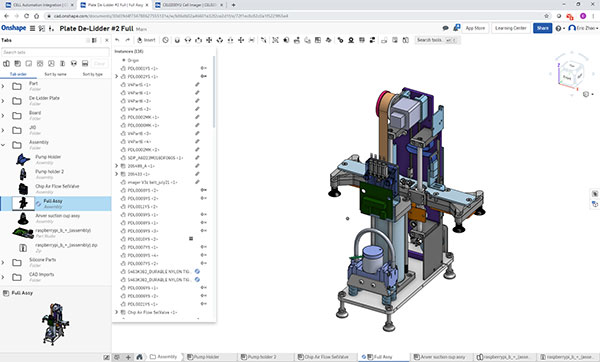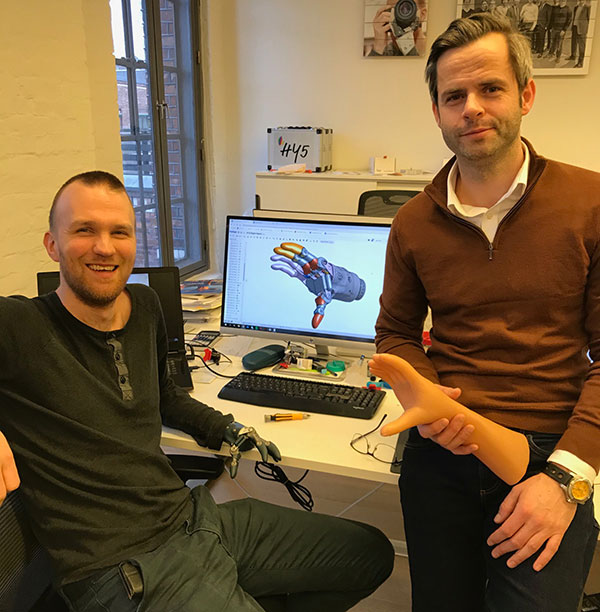COVID-19 Spike Puts Remote Collaboration to the Test
Design tool vendors ease licensing restrictions and aim for scalability to meet surge in demand from work-at-home engineers.

Onshape’s cloud-native product development platform is uniquely suited to remote teams, allowing engineers to work from anywhere on any computer, tablet or phone. Image courtesy of Onshape.
Latest News
April 6, 2020
The COVID-19 pandemic has forced many people into a new work-from-home climate that while challenging for all, is particularly taxing for engineering organizations, which are dependent on high-octane computing horsepower and graphics-intensive design software to get their jobs done.
Staples like CAD, simulation and high-end visualization and design tools are typically run on on-premises, on individual workstations, desktops and the occasional laptop due to their hefty requirements for raw compute and graphics processing units (GPU) horsepower. Engineering organizations, unlike other areas of the business, have also been more resistant to switching their core design tools to a cloud-based model due to concerns about performance and in many cases, the security of critical design intellectual property (IP).

Now weeks into the global coronavirus outbreak, the reticence over a software-as-a-service deployment model and cloud-based design collaboration has been cast aside—at least for the foreseeable future. Millions of workers, including engineers, are now under stay-at-home or shelter-in-place orders, and thus are scrambling to get their home workspaces in order and their mobile systems appropriately configured for remote work, including their favorite design tools. Indeed, vendors offering cloud-based design tools and remote collaboration platforms are reporting an uptick in demand for those services and are responding with special offers and revamped license plans that make it easy for existing customers to expand usage of cloud-based tools while encouraging long-standing hold-outs to finally take a test drive.
“We’re definitely seeing increased interest and usage at a professional level,” says David Katzman, vice president of customer experience and strategy at PTC, which recently acquired Onshape, a cloud-based CAD platform. “People are just starting to wrap their head around this so it takes some time.”

Licensing for the New Normal
One of the biggest issues for engineering groups still fully reliant on on-premise systems is how to access their critical design tools when working from home. There are myriad roadblocks, from problems that make it difficult to tap into the software through the corporate virtual private networks (VPNs) to bandwidth concerns given the high-volumes of users logging on to limitations with existing software licenses. In many cases, collaboration is stymied by technical issues—for example, internet compatibility issues with older servers or concerns that remote access identities might cause out-of-sync files, which could ultimately cause collaboration miscues and design errors down the road.
“What we’re hearing most from customers—and facing ourselves at Autodesk—involves adapting to the new work-at-home environment and making it the new normal,” says a spokesperson at Autodesk. “With more people working remotely or from home, the ability to collaborate and stay connected is important to maintain productivity, ease stress, and boost morale.”
To minimize disruption to businesses and better support its customers, Autodesk is offering a temporary Extended Access Program for several of its flagship cloud collaboration products. Specifically, the Extended Access Program allows free commercial use of several of Autodesk cloud collaboration products, including BIM 360 Docs, BIM 360 Design, Fusion 360, Fusion Team, AutoCAD Web and Mobile, and Shotgun until May 31, 2020. The program is available to both new customers as well as existing customers who need to quickly expand usage of these products to accommodate their now dispersed and remote work-from-home teams.
“Our goal is to get a program up and running as quickly as possible to provide customers access to products they need to do their jobs and increase flexibility in a challenging work environment,” the Autodesk spokesperson says. “We are continually monitoring the needs of our customers and the situation surrounding the global outbreak and may make modifications to the program, including products, as we see fit.”

For Onshape, the pandemic has definitely prompted an uptick in usage from new customers, but for its internal employees and existing user base, the environment is pretty consistent with how they’ve always worked. Research from Onshape shows that even before the pandemic, over half of employees were working outside of their main office headquarters, at least two and a half days a week. Moreover, a 2019 IWG Global Workspace Survey found that 85% of respondents report better employee productivity when there is flexibility in terms of workspace and hours.
Because the Onshape platform was designed from the ground up as a cloud platform and because it forgoes the traditional file-based architecture of most CAD tools for a database-oriented approach, there have been little to no performance issues even with the spike in usage, PTC's Katzman says. He says PTC and Onshape are transparent with their performance numbers and directed those interested to check out status.onshape.com to review published benchmarks.

“With a modern SaaS offering, no one thinks about how many people are using the system at any given point in time,” Katzman says. “The system should work whether there are five, 500, or 5,000 users and we’ve built in a lot of automation and tooling so that we can scale automatically. We don’t have to do anything to enable scaling up as more users sign on to the system.”
OnScale, a cloud-based multiphysics simulation platform, is also seeing a surge in interest in its cloud-based offerings, including from users of its on-premise and hybrid solutions keyed to a desktop license, according to Ian Campbell, the company’s CEO. Those customers, who decided to pass on the cloud option due to IT security concerns, among other reasons, are now interested in the deployment model due to their need to accommodate engineers working remotely who no longer have access to their high-powered enterprise workstations.
“The tradeoff is having highly-paid engineers not being able to do anything or relaxing some security protocols to access the OnScale cloud and they’re doing the later,” notes Campbell. “They need to keep these guys productive—it could become a permanent fixture of the economy going forward.”
Campbell says OnScale has definitely seen some hiccups in performance due to the increased volumes, but it is working with partners like AWS, Google Cloud Platform and Azure to ensure additional resources are allocated to address any latency issues. Running sophisticated Multiphysics simulation in the cloud demands a lot more horsepower than what’s required to stream a Netflix show or handle gaming, Campbell says. “Our requirements call for top-of-the-line systems like 96-core bare metal machines, 100GB of RAM, and tightly co-located infinity band backplane speeds with 100 gigabit per second interconnects,” he explains. “We are working like mad [with partners] to beef up the infrastructure accordingly.”
Outside of bolstering capacity to meet increased performance demands, OnScale is also easing some of its license constraints. The company is offering free cloud core hours to its on-premise customers currently working from home and who don’t have access to their on-premise workstations or other hardware infrastructure along with their OnScale engineering simulation platform.
Altair, which provides simulation software and high performance computing (HPC) solutions for engineers, says licensing constraints are the biggest issues for companies struggling to get their engineering teams access to mission-critical design software, says Sam Mahalingam, the company’s chief technology officer. “The problem they have is drilling holes into their firewalls to access software based on on-premise licenses,” he says. “Then they are loading up their VPNs and servers because people are working from home.”
Altair had addressed this issue for customers prior to the COVID-19 outbreak. The company’s patented units-based licensing model and the ability for Altair to host a company’s HyperWorks server provides flexibility, allowing engineers to access the simulation portfolio from anywhere, from the cloud to their laptop at home. “We’ve seen demand spike over the last few weeks for enterprises saying they don’t want to host their own servers, but rather move units to a hosted server to give employees ease of access,” Mahalingam says.
Another way organizations are tapping Altair technology to empower their remote engineering teams is with Access, which provides an interface for submitting and monitoring HPC jobs on remote clusters and clouds. With Altair Access, users can seamlessly submit remote jobs and monitor results and there are collaboration tools to keep far flung teams connected. Companies can also take advantage of Altair HyperWorks Unlimited, a turnkey simulation and high performance computing appliance available in both on-premises and cloud-based deployment options as well as Altair PBS Works, a web portal interface for managing HPC resources.
“Not only do [these solutions] provide smooth access to our tools, they reduce IT overhead because they don’t have to scale up VPN infrastructure,” Mahalingam says. “It lets designers seamlessly have access to our tools so they can continue innovation.”
More Altair Coverage
More Autodesk Coverage
More OnScale Coverage

More Onshape Coverage
More PTC Coverage
Subscribe to our FREE magazine, FREE email newsletters or both!
Latest News
About the Author
Beth Stackpole is a contributing editor to Digital Engineering. Send e-mail about this article to [email protected].
Follow DE








